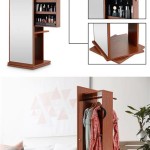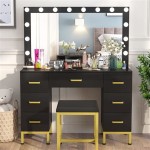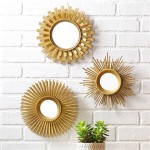How Heavy Is A Wall Mirror?
The weight of a wall mirror is a significant consideration when choosing and installing it. The weight influences mounting hardware requirements, ease of handling, and the structural integrity of the wall to which it will be affixed. The weight is not a fixed value; rather, it varies considerably based on several factors relating to the mirror's size, construction, and materials.
Understanding the elements that contribute to a mirror's weight allows for a more informed decision-making process when purchasing and installing one. This article will explore the various factors that determine the weight of a wall mirror, providing insights into the range of weights one can expect and the implications for installation.
Factors Influencing Wall Mirror Weight
Several factors contribute to the overall weight of a wall mirror. These factors are interconnected and can significantly impact the final weight. A comprehensive understanding of these factors is essential for proper installation and ensuring the mirror is safely mounted.
Size and Dimensions: The most obvious factor influencing a mirror's weight is its size. Larger mirrors, naturally, contain more material and therefore weigh more. The dimensions of the mirror, including both its length and width, directly translate to the surface area. The larger the surface area, the greater the quantity of glass required, leading to a heavier mirror.
The relationship between size and weight is not always linear. As dimensions increase, the thickness of the glass may also need to increase to maintain structural integrity and prevent warping or breakage. This increase in thickness further contributes to the overall weight.
Glass Thickness: Glass thickness is a critical factor in determining the overall weight. Mirror glass is typically thicker than standard window glass to provide increased rigidity and prevent distortion. Common thicknesses for wall mirrors range from 1/8 inch (3mm) to 1/4 inch (6mm), and even thicker for larger or more specialized mirrors.
The relationship between thickness and weight is directly proportional. Doubling the thickness of the glass roughly doubles its weight, assuming all other factors remain constant. This increased weight necessitates stronger mounting hardware and careful consideration of the wall's load-bearing capacity.
Frame Material: The frame surrounding the mirror also contributes significantly to its weight. Different frame materials have vastly different densities, which directly affects the overall weight of the assembled mirror. Common frame materials include wood, metal, and synthetic alternatives.
Wooden frames can vary in weight depending on the type of wood used. Hardwoods like oak or maple are generally heavier than softwoods like pine or fir. The size and thickness of the wooden frame also play a role. Intricately carved or substantial wooden frames will naturally add more weight than simpler, slimmer frames.
Metal frames, commonly made from steel, aluminum, or brass, can also vary considerably in weight. Steel is generally the heaviest of these metals, while aluminum is the lightest. The gauge or thickness of the metal also influences its weight. Thicker metal frames provide greater structural support but add to the overall weight.
Synthetic frame materials, such as polystyrene or acrylic, are typically lighter than wood or metal. These materials offer a cost-effective and lightweight alternative, but they may not provide the same level of durability or aesthetic appeal as natural materials.
Backing Material: The backing material applied to the back of the mirror, often a thin layer of paint or a more substantial backing board, provides protection to the reflective coating and adds structural support. This backing material, while usually less significant than the glass or frame, still contributes to the overall weight.
Thin paint coatings add negligible weight. However, more substantial backing boards, such as plywood or MDF (medium-density fiberboard), can add a noticeable amount of weight, especially on larger mirrors. The thickness and density of the backing board directly influence its contribution to the overall weight.
Typical Weight Ranges For Different Mirror Sizes
The weight of a wall mirror can vary substantially depending on its size. Here are some typical weight ranges for common mirror sizes, keeping in mind that these are estimates and can vary based on the factors discussed above:
Small Mirrors (e.g., 12" x 18"): Small mirrors, often used in bathrooms or as decorative accents, typically weigh between 3 to 8 pounds. These smaller sizes generally use thinner glass and lighter frames, resulting in a manageable weight for most standard mounting hardware.
Medium Mirrors (e.g., 24" x 36"): Medium-sized mirrors, commonly found in bathrooms or bedrooms, tend to weigh between 10 to 25 pounds. The increased surface area necessitates thicker glass and more substantial framing, contributing to the higher weight range.
Large Mirrors (e.g., 36" x 48"): Large mirrors, often used in dressing rooms or as full-length mirrors, can weigh between 25 to 50 pounds or more. These large sizes require robust construction and thicker glass to maintain structural integrity, resulting in a significantly higher weight.
Oversized Mirrors (e.g., 48" x 72" or larger): Oversized mirrors, often used as decorative features in living rooms or entryways, can weigh upwards of 50 pounds and potentially exceed 100 pounds. These mirrors require professional installation and specialized mounting hardware to ensure they are securely and safely mounted.
It is crucial to consult the manufacturer's specifications or weigh the mirror before installation to determine its exact weight. This information is essential for selecting the appropriate mounting hardware and ensuring the wall can safely support the mirror's weight.
Implications For Installation and Wall Support
The weight of a wall mirror has significant implications for its installation. Choosing the correct mounting hardware and ensuring adequate wall support are crucial for preventing damage to the mirror, the wall, and potential injury.
Mounting Hardware Selection: The weight of the mirror directly dictates the type and strength of the mounting hardware required. Lightweight mirrors can often be safely mounted using simple hooks or adhesive strips. However, heavier mirrors necessitate more robust hardware, such as heavy-duty picture hooks, D-rings, wire, or Z-bar hangers.
It is essential to choose mounting hardware that is rated to support at least the weight of the mirror, and preferably with a safety margin. Using undersized or inadequate hardware can lead to the mirror detaching from the wall, resulting in damage or injury.
Wall Type and Support: The type of wall to which the mirror will be mounted is another critical consideration. Standard drywall walls have limited load-bearing capacity. Mounting heavy mirrors directly to drywall without proper support can lead to the drywall crumbling or the mirror pulling away from the wall.
For heavier mirrors, it is recommended to anchor the mounting hardware to wall studs. Wall studs are vertical framing members within the wall that provide significant structural support. Using a stud finder to locate the studs and attaching the mounting hardware directly to them ensures a secure and stable installation.
If wall studs are not conveniently located, or if the mirror is too large to be mounted solely on studs, alternative solutions include using drywall anchors or installing a backing board. Drywall anchors are designed to distribute the weight of the mirror over a larger area of the drywall, providing increased support. A backing board, typically made of plywood, can be attached to the wall studs, creating a solid surface to which the mirror can be mounted.
Professional Installation: For particularly large or heavy mirrors, professional installation is highly recommended. Professional installers have the experience and expertise to properly assess the wall's structure, select appropriate mounting hardware, and ensure the mirror is securely and safely mounted. They can also provide guidance on the best placement for the mirror to maximize its aesthetic appeal and functionality.
Furthermore, professional installers often carry insurance that covers any potential damage or injury that may occur during the installation process. This provides added peace of mind, knowing that you are protected from liability in the event of an accident.
In conclusion, understanding the factors contributing to the weight of a wall mirror, the typical weight ranges for different sizes, and the implications for installation is essential for ensuring a safe and successful mounting process. Careful consideration of these factors, along with the appropriate selection of mounting hardware and wall support, will help to prevent damage, injury, and ensure that your wall mirror remains securely in place for years to come.

How To Hang A Large Or Heavy Mirror
How To Hang A 100 Pound Mirror On Drywall Quora
:max_bytes(150000):strip_icc()/how-to-hang-heavy-mirror-4842125-hero-60a5b78ee9e7480da50b75205681c214.jpg?strip=all)
How To Hang A Heavy Mirror
:strip_icc()/ScreenShot2022-04-28at1.12.19PM-e055476c70c6438585fa7c5cd531edcf.png?strip=all)
4 Easy Ways To Hang A Heavy Mirror

How To Hang A Heavy Full Length Leaner Mirror On The Wall Hanging Over Door Mirrors

How To Hang A Heavy Mirror Lowe S

How To Hang A Heavy Mirror The Home Depot
:max_bytes(150000):strip_icc()/how-to-hang-heavy-mirror-4842125-08-c35627d37fdb44678b20c10d589bdbb4.jpg?strip=all)
How To Hang A Heavy Mirror

How To Hang A Very Heavy Picture Or Mirror The Best

Large Heavy Mid Century Italian Wall Mirror With An Ornate Brass Frame For At Pamono








